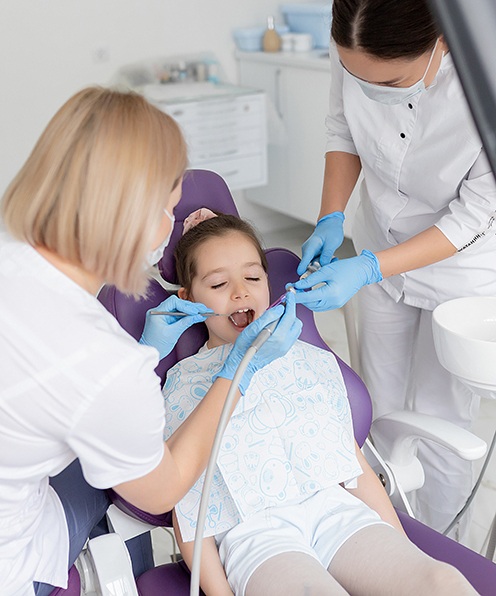Pulp Therapy – Buffalo Grove, IL
Giving Your Child’s Tooth Another Chance
Did you know that cavities are among the most common oral health issues in children? According to the Centers for Disease Control and Prevention, over 50% of children under the age of 8 have had at least one cavity in their baby teeth! Sometimes cavities can be treated with dental fillings, but in more severe cases, a procedure known as pulp therapy might have to be used to save the tooth in question. To learn more about pulp therapy or to get in touch with our team to see if your child could benefit from this procedure, continue reading or contact our office today!
Why Choose Capezio Pediatric Dentistry for Pulp Therapy?
- Two Experienced Pediatric Dentists on Staff
- Dental Insurance Proudly Accepted
- Same-Day Emergency Appointments Available
Does Your Child Need Pulp Therapy?

Inflamed or injured pulp that results from a severe cavity is an exceptionally painful issue, and your child will likely express discomfort with one of their teeth when it happens. Even if the source of the pain isn’t visible, it will quickly become obvious. Some other signs to look for include:
- Constant unexplained pain, especially during the nighttime.
- Sensitivity to warm and cool foods and drinks.
- Swelling or redness around the affected tooth.
- Unexpected looseness or mobility of the affected tooth.
The Pulp Therapy Process

Once we’ve determined that pulp therapy is needed, we’ll speak with you about what you and your child can expect during the appointment. Your child’s mouth will be sufficiently numbed with a local anesthetic so that they don’t feel any discomfort, and from there, we’ll get started. We will remove the infected structure of the baby tooth, including portions of the pulp or nerve center. We’ll also clean and sanitize the tooth before refilling its structure as needed, either with the help of a filling or a crown.
The Benefits of Pulp Therapy

Even though baby teeth are intended to fall out, it’s still beneficial to restore them with pulp therapy when they become compromised with decay – this is since they help to guide future dental development! Extraction should only be seen as a last resort. If baby teeth are lost too early, the permanent teeth forming underneath can line up incorrectly. Plus, without a complete set of teeth, your child may struggle to eat and speak clearly. Perhaps the biggest benefit of pulp therapy is the pain relief it provides for your child, though; rather than simply addressing the symptoms of the pain, pulp therapy is designed to completely address its source and ensure that it doesn’t come back.
Pulp Therapy FAQs
What Is the Difference Between Pulp Therapy and a Root Canal?
Pulp therapy and root canal treatment both address issues within the tooth’s pulp, but they differ in approach and purpose. Pulp therapy, often called a “root canal for kids,” focuses on preserving the vitality of a child’s tooth by treating only the affected portion of the pulp. This is a conservative approach that allows a baby tooth to remain functional until it is naturally lost.
In contrast, a traditional root canal involves removing all of the pulp tissue from an adult tooth in order to save a tooth that would otherwise need extraction. The primary goal with pulp therapy in children is to support proper oral development and maintain space for the permanent teeth to erupt normally.
What Are the Two Different Types of Pulp Therapy?
There are two main types of pulp therapy: pulpotomy and pulpectomy. A pulpotomy removes the infected or inflamed portion of the pulp located in the crown of the tooth, while leaving the healthy pulp in the roots intact. This method helps retain the vitality of the remaining pulp and supports continued tooth development.
A pulpectomy, on the other hand, becomes necessary when the infection or inflammation extends throughout the entire pulp chamber, including the roots. During a pulpectomy, all pulp tissue is removed and the area is cleaned and filled with a safe material. Our dental team will recommend the most appropriate treatment based on your child’s individual needs.
How Long Will It Take for My Child to Recover from Pulp Therapy?
Most children recover quickly after pulp therapy, often resuming normal activities within a day. While some mild discomfort or sensitivity can occur shortly after the procedure, this usually resolves within a few days. We recommend offering a soft diet and over-the-counter pain relief, if necessary, to ensure your child’s comfort.
Follow-up visits are essential to monitor healing and confirm the tooth’s health. Our dental team will provide personalized aftercare instructions and remain available to address any concerns. Prompt recovery depends on good oral hygiene and attending scheduled dental checkups.
Is Pulp Therapy Painful?
We understand that parents worry about their child’s comfort during dental procedures. Pulp therapy is performed under local anesthesia to ensure that your child feels little to no discomfort throughout the treatment. Our team prioritizes gentle care and takes steps to ease any anxiety your child may experience. We even have a special device that administers local anesthesia in a gentle and comfortable manner.
After the procedure, some children may report soreness or sensitivity, but these symptoms typically subside quickly. If your child expresses ongoing discomfort, please let our Buffalo Grove team know so we can provide appropriate support.
Is Pulp Therapy Safe?
Pulp therapy is a safe and effective way to preserve your child’s natural teeth and promote healthy oral development. Our pediatric dental specialists use evidence-based techniques and materials designed specifically for children to minimize risk and optimize patient outcomes.
If you have questions about potential complications and side effects, feel free to talk to our team.

